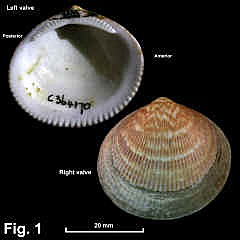|
|
GLYCYMERIDIDAE |
|
|
|
Glycymeris striatularis (Lamarck, 1819) Description: Shell solid, heavy, equivalve, nearly equilateral. Shape almost circular, sometimes extended posteriorly. Anterior end smoothly rounded, posterior similarly rounded or weakly angled. Umbones low, centrally placed or a little forward of midline. Hinge line curved, 7-12 teeth each side, area between smooth or with a few weak teeth. Ligament in a wide, triangular pit above hinge. Interior white, irregularly splashed with brown; muscle scars well defined with a ridge from inner edge of each scar towards umbones, stronger on posterior side; margin strongly denticulate. Exterior with flattened radial ribs, the whole surface with finer secondary radial riblets, about 5 on each major rib. Periostracum velvety, often restricted to margin. Shell patterned with concentric brown bands, in zigzag pattern near umbones. Size: Up to 50 mm in length. Distribution: Fraser Island, Qld, southwards and around southern Australia, to Port Gregory (near Geraldton) WA, including Tas. Habitat: Intertidal and subtidal in sand and gravel, with living specimens known down to 140 m. Commonly washed up on exposed beaches in southern Australia. Comparison: See G. holoserica. Synonymy: Iredale named the shells from eastern Tasmania and Twofold Bay, NSW, as Glycymeris striatularis suspectus Iredale, 1924 as he regarded them as thinner and more oblique than western Australian shells (This has previously been recognised as a synonym). This distinction cannot be maintained when a large range of specimens is examined. Fig. 1: Collaroy Beach, Sydney, NSW. (C.364170) |
|
